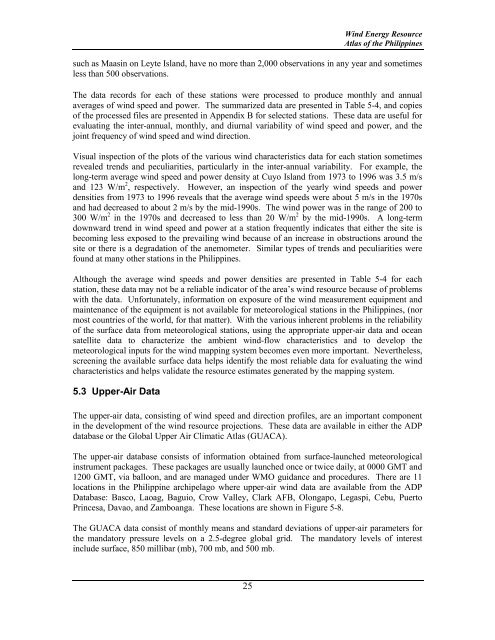Wind Energy Resource Atlas of the Philippines - NREL
Wind Energy Resource Atlas of the Philippines - NREL
Wind Energy Resource Atlas of the Philippines - NREL
You also want an ePaper? Increase the reach of your titles
YUMPU automatically turns print PDFs into web optimized ePapers that Google loves.
25<br />
<strong>Wind</strong> <strong>Energy</strong> <strong>Resource</strong><br />
<strong>Atlas</strong> <strong>of</strong> <strong>the</strong> <strong>Philippines</strong><br />
such as Maasin on Leyte Island, have no more than 2,000 observations in any year and sometimes<br />
less than 500 observations.<br />
The data records for each <strong>of</strong> <strong>the</strong>se stations were processed to produce monthly and annual<br />
averages <strong>of</strong> wind speed and power. The summarized data are presented in Table 5-4, and copies<br />
<strong>of</strong> <strong>the</strong> processed files are presented in Appendix B for selected stations. These data are useful for<br />
evaluating <strong>the</strong> inter-annual, monthly, and diurnal variability <strong>of</strong> wind speed and power, and <strong>the</strong><br />
joint frequency <strong>of</strong> wind speed and wind direction.<br />
Visual inspection <strong>of</strong> <strong>the</strong> plots <strong>of</strong> <strong>the</strong> various wind characteristics data for each station sometimes<br />
revealed trends and peculiarities, particularly in <strong>the</strong> inter-annual variability. For example, <strong>the</strong><br />
long-term average wind speed and power density at Cuyo Island from 1973 to 1996 was 3.5 m/s<br />
and 123 W/m 2 , respectively. However, an inspection <strong>of</strong> <strong>the</strong> yearly wind speeds and power<br />
densities from 1973 to 1996 reveals that <strong>the</strong> average wind speeds were about 5 m/s in <strong>the</strong> 1970s<br />
and had decreased to about 2 m/s by <strong>the</strong> mid-1990s. The wind power was in <strong>the</strong> range <strong>of</strong> 200 to<br />
300 W/m 2 in <strong>the</strong> 1970s and decreased to less than 20 W/m 2 by <strong>the</strong> mid-1990s. A long-term<br />
downward trend in wind speed and power at a station frequently indicates that ei<strong>the</strong>r <strong>the</strong> site is<br />
becoming less exposed to <strong>the</strong> prevailing wind because <strong>of</strong> an increase in obstructions around <strong>the</strong><br />
site or <strong>the</strong>re is a degradation <strong>of</strong> <strong>the</strong> anemometer. Similar types <strong>of</strong> trends and peculiarities were<br />
found at many o<strong>the</strong>r stations in <strong>the</strong> <strong>Philippines</strong>.<br />
Although <strong>the</strong> average wind speeds and power densities are presented in Table 5-4 for each<br />
station, <strong>the</strong>se data may not be a reliable indicator <strong>of</strong> <strong>the</strong> area’s wind resource because <strong>of</strong> problems<br />
with <strong>the</strong> data. Unfortunately, information on exposure <strong>of</strong> <strong>the</strong> wind measurement equipment and<br />
maintenance <strong>of</strong> <strong>the</strong> equipment is not available for meteorological stations in <strong>the</strong> <strong>Philippines</strong>, (nor<br />
most countries <strong>of</strong> <strong>the</strong> world, for that matter). With <strong>the</strong> various inherent problems in <strong>the</strong> reliability<br />
<strong>of</strong> <strong>the</strong> surface data from meteorological stations, using <strong>the</strong> appropriate upper-air data and ocean<br />
satellite data to characterize <strong>the</strong> ambient wind-flow characteristics and to develop <strong>the</strong><br />
meteorological inputs for <strong>the</strong> wind mapping system becomes even more important. Never<strong>the</strong>less,<br />
screening <strong>the</strong> available surface data helps identify <strong>the</strong> most reliable data for evaluating <strong>the</strong> wind<br />
characteristics and helps validate <strong>the</strong> resource estimates generated by <strong>the</strong> mapping system.<br />
5.3 Upper-Air Data<br />
The upper-air data, consisting <strong>of</strong> wind speed and direction pr<strong>of</strong>iles, are an important component<br />
in <strong>the</strong> development <strong>of</strong> <strong>the</strong> wind resource projections. These data are available in ei<strong>the</strong>r <strong>the</strong> ADP<br />
database or <strong>the</strong> Global Upper Air Climatic <strong>Atlas</strong> (GUACA).<br />
The upper-air database consists <strong>of</strong> information obtained from surface-launched meteorological<br />
instrument packages. These packages are usually launched once or twice daily, at 0000 GMT and<br />
1200 GMT, via balloon, and are managed under WMO guidance and procedures. There are 11<br />
locations in <strong>the</strong> Philippine archipelago where upper-air wind data are available from <strong>the</strong> ADP<br />
Database: Basco, Laoag, Baguio, Crow Valley, Clark AFB, Olongapo, Legaspi, Cebu, Puerto<br />
Princesa, Davao, and Zamboanga. These locations are shown in Figure 5-8.<br />
The GUACA data consist <strong>of</strong> monthly means and standard deviations <strong>of</strong> upper-air parameters for<br />
<strong>the</strong> mandatory pressure levels on a 2.5-degree global grid. The mandatory levels <strong>of</strong> interest<br />
include surface, 850 millibar (mb), 700 mb, and 500 mb.
















